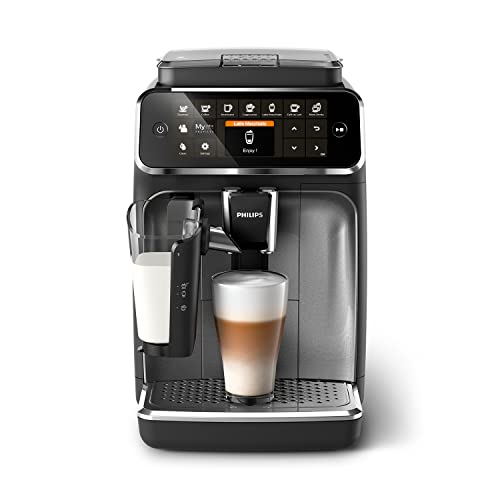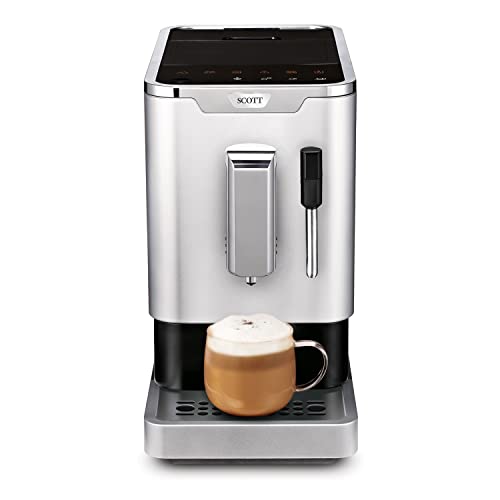How Bean Coffee Machine Changed Over Time Evolution Of Bean Coffee Mac…
페이지 정보

본문
 Coffee Bean Coffee Machines
Coffee Bean Coffee MachinesWhen you buy a coffee bean machine, you can enjoy delicious, fresh whole-bean coffee made to your exact specifications. The machine grinds, measures, tamps and pushes hot water into the ground to produce rich, delicious coffee machine from beans.
These machines have several advantages over pod machines, such as less environmental waste, and a simple to use. The machine is fully automated and operates at the touch of one button.
The following are alternatives to the word "grind"
The type of grind you use is essential to making a good cup of coffee. The particle size, shape, and consistency are all crucial. If you do not grind beans correctly, the water will move through the beans too quickly. This could result in a bitter taste or a lack of flavor.
A good grinder should have a variety of grind sizes to allow you to select the most suitable method to brew your drink. It is important to experiment with different sizes of grind because this can significantly alter the flavor of your coffee. The smallest particles are best for espresso and French presses, while larger, coarser pieces are better for immersion brewing, such as with the Moka pot or Chemex.
If you're looking to make an even more gourmet cup of coffee, consider roasting your own beans and grinding them prior to making your coffee. This will increase the aroma and flavor of your brew and help create a perfect cup every time. It's also important to store the beans in an airtight container an environment that is cool and dark to ensure their freshness and flavor.
Commercial machines that make coffee offer unbeatable convenience. They let you enjoy barista quality coffee with the click of a button. These machines can handle everything, from preparing the coffee beans to the tamping process. They are an ideal choice for busy offices and cafes.
The first step is to grind your beans to a precise size. They can be set up to suit your preferred brewing method and are able to be programmed to serve the desired amount of cups at a time. Some machines will automatically tamp down the grounds for you to create an extremely compacted puck of coffee, ensuring most consistent extraction possible.
A bean-to-cup machine usually includes a large hopper you can fill with whole beans. The machine will automatically grind beans before dispensing the right amount of your chosen brew. The machines usually have a display on them to display the size of grind and dosage selected along with the total amount of drinks it's designed to make.
Extraction
When a coffee bean is crushed it breaks up into smaller pieces called particles. The size of these particles could have a big impact on the extraction process and therefore how good the finished cup will taste. In a bean-to-cup machine, the size of the beans is controlled prior making coffee so that it lines with the type of extraction needed by the machine. This lets you enjoy a great cup of coffee every time, and does not require the skills of a barista.
The brew time in a machine that is bean to cup can be controlled to achieve precisely the strength you desire to drink. This is a major advantage over pod machines which give you less control and could result in less flavorful or bitter espresso. Bean-to-cup machines let you control not only the brew time as well as the water temperature. This lets you determine how strong the coffee will be.
Extraction is an extremely delicate process that is dependent on the proper proportion of particle size, dose and tamping pressure. A coffee that is not extracted properly could be the result of any of these factors. Coffee that isn't extracted enough will taste sour and sharp and coffee that is extracted too much will taste dry and bitter.
To ensure that your coffee is extracted correctly, you need to make use of a top-quality grinder and the right type beans. Light roasts are not a good choice for espresso or fully automatic machines because the short extraction time could leave the coffee lacking body and flavor. Darker roasts with a high Robusta percentage, like our Jhai (100 percent Robusta) or Tiga Terra are better for these machines due to the fact that they have more robust flavors and bodies.
The decision between a pod-based machine and a bean to cup maschine-to-cup machine ultimately comes down to the convenience factor and personal preference. Pod coffee machines are convenient for making tea and coffee. However, they can be less cost-effective and generate waste when disposed of used pods.
Dispensing
When you use whole beans, you can save money and have more flexibility. This also means that you will need to do more maintenance and cleaning of your machine than you would with a pod-based machine.
These machines are designed to be low-maintenance, and have many features that make the task easier. Many bean-to-cup coffee makers are equipped with automatic cleaning and rinsing cycles. This makes it simple to maintain your machine without disrupting daily operations.
Another feature that is useful is the ability to add steaming hot milk to coffee drinks. This allows your team to modify their drinks to their tastes and preferences while increasing productivity. It is also a great way to show your team that you care about their wellbeing. In fact it has been proven scientifically that coffee boosts dopamine and norepinephrine production, which boosts motivation and focus in the workplace.
Some models even offer customizable options for beverages, such as texturizing the milk in cappuccinos and lattes. This is a huge draw for baristas who have only a short amount of time to make each cup of coffee.
The size of the water tank as well as the bean to cup automatic coffee machine hopper are important features to look for when selecting a top-quality bean-to cup coffee maker. The water tank determines the amount of time that the machine can run before it has to be filled up, and the size of the hopper affects the frequency at which you'll have to replenish the beans. The larger the capacity, the less often you'll have to replenish.
It is important to consider the type of beans to coffee machine you will be using prior to purchasing a bean to cup coffee maker. Different grind sizes can alter the flavor and consistency in each cup. Also, you should check the machine's programmable settings, which allow users to tweak aspects of their drinks to make their perfect beverage every time.
The spouts for dispensing coffee from your coffee bean machine may get blocked by coffee residue or other debris left over after grinding. The spouts must be cleaned frequently to prevent slow and inconsistent flow, which could result in insufficient dosing of grounds of coffee. This can be due to a coarser grind setting or dried or oily beans, or lack of regular cleaning.
Cleaning
Cleaning coffee machines is a vital aspect of maintaining them. It prevents the buildup and accumulation of residues that can affect the taste and quality of the coffee. Regular cleaning helps keep the machine in good condition and reduces the chance of a failure that can result in a large repair bill. A majority of bean-to-cup coffee machines have a built in daily cleaning cycle that will flush the pipes and clean the brewing unit while some will have a separate, milk side cleaning cycle to ensure the spouts are cleaned thoroughly.
A good rental provider will typically train employees on the entire cleaning and maintenance process during installation. This will help to minimise any confusion over the process and ensure that every step is followed correctly. With clear instructions and a complete understanding of the process can assist in avoiding any mistakes that could result in costly repairs or poor quality drinks.
It is recommended to clean the carafe, the permanent filter, and brew basket following each use in hot soapy water or in the dishwasher if they are designated as safe for this. It is also recommended to run three or more times of fresh water, without K cups or ground coffee in the machine between uses. This helps flush out any oily residue and stop the growth of yeast, bacteria or mould.
For single-serve or pod coffee bean coffee Machine makers, it is a good idea to do a deep clean and descale at least every 4 weeks. A vinegar solution is typically used for this. Add up to four cups of vinegar to the reservoir and then run the machine through a brewing cycle. When the cycle is finished, rinse and descale according to the instructions of the manufacturer and run a couple of cycles of fresh water to get rid of any vinegar odor.
 Commercial machines are equipped with a telemetry system which logs every cleaning cycle. Your supplier or you can view this to ensure that the machine is maintained regularly. This could also alert you to any moving parts that have become seized or stuck, which could require more detailed repair and maintenance work.
Commercial machines are equipped with a telemetry system which logs every cleaning cycle. Your supplier or you can view this to ensure that the machine is maintained regularly. This could also alert you to any moving parts that have become seized or stuck, which could require more detailed repair and maintenance work.- 이전글The Reason Why Everyone Is Talking About Sectional Sleeper Sofa Right Now 24.09.16
- 다음글The Most Hilarious Complaints We've Seen About Mazda Replacement Key 24.09.16
댓글목록
등록된 댓글이 없습니다.